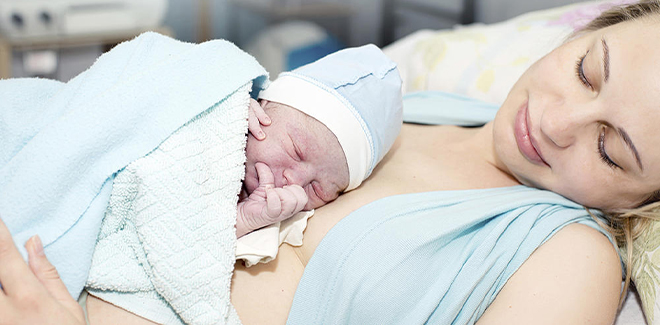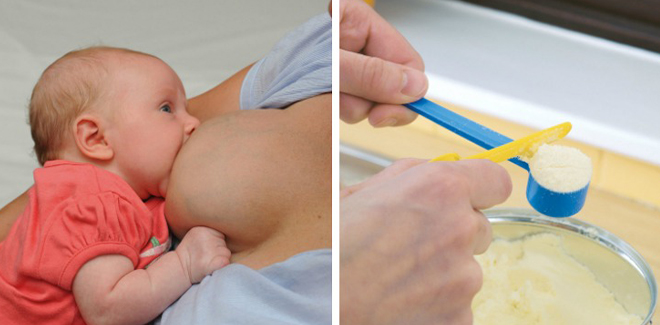A combination of Postpartum recovery and natural delivery and emotional adjustment at this time lays the groundwork for the mother’s well-being and her ability to nurture her baby. Understanding the intricacies of postpartum recovery after a natural birth is critical to a smooth transition into this new chapter of life.
Natural childbirth is a testament to the human body’s innate capabilities, allowing women to bring forth life in its purest form. As the birthing process unfolds naturally, it often leads to a gentler physical impact on the body compared to medical interventions. This can contribute to a potentially smoother postpartum recovery. During this period, the body gradually heals from the strains of childbirth, including any potential tearing or stretching. Adequate rest, nutrition, and gentle exercises tailored to the postpartum stage play pivotal roles in restoring strength and vitality. Emotional well-being is equally crucial; the experience of natural childbirth can empower mothers, boosting their self-confidence as they navigate the challenges of early motherhood. In this article, we delve into the intricate dance of postpartum recovery after natural childbirth, offering insights, tips, and guidance to help mothers embrace this transformative phase with confidence and grace.

Postpartum recovery and natural delivery
The recovery period for a mother after a natural birth can vary, but on average it takes about 6 weeks for the body to recover and for the mother to feel more herself again. However, full recovery, both physically and emotionally, can take longer than that. Here’s an overview of the Postpartum recovery and natural delivery:
First Few Days:
- Immediately after childbirth, the body begins the process of uterine involution, which is the shrinking of the uterus back to its pre-pregnancy size. This process is aided by breastfeeding, as it triggers the release of oxytocin, which helps the uterus contract.
First Week:
- The mother will experience postpartum bleeding known as lochia. This is similar to a heavy period and gradually changes in color and flow as the days pass.
- Physical discomfort, including soreness in the perineum or vaginal area (if there was tearing or stretching during childbirth), may be experienced.
First Few Weeks:
- Lochia continues but gradually tapers off.
- The perineum starts to heal, and any stitches or tears begin to mend.
- Energy levels might still be low, and the mother should prioritize rest and self-care.
- Breastfeeding challenges and hormonal changes can contribute to emotional ups and downs.
Around 6 Weeks:
- By this time, most women have their postpartum check-up with their healthcare provider to assess the healing process and overall well-being.
- Physical healing from childbirth, including any stitches or tears, is often well underway.
- The mother might start feeling more comfortable and be able to engage in light exercises, if cleared by her healthcare provider.
It’s important to note that while the physical healing timeline follows a general pattern, the emotional recovery varies widely from person to person. Some mothers might experience the “baby blues,” a temporary and mild form of mood changes, while others might face more significant emotional challenges such as postpartum depression or anxiety.
Every woman’s recovery journey is unique, influenced by various factors such as the woman’s health before and during pregnancy, the type of birth experience, support system, and more. It’s crucial for mothers to listen to their bodies, seek medical advice when needed, and prioritize self-care during this transformative period.

Vaginal bleeding and discharge after natural delivery
Vaginal bleeding and discharge after natural delivery are common occurrences and are part of the body’s natural healing process. This postpartum bleeding and discharge are collectively referred to as “lochia.” Lochia consists of blood, mucus, and uterine tissue that are expelled from the uterus as it undergoes involution, returning to its pre-pregnancy size.
Here’s a breakdown of the different stages of lochia and what to expect:
- Lochia Rubra (Days 1-3):
- In the immediate days following childbirth, lochia appears bright red in color due to the presence of fresh blood.
- The bleeding can be heavy, similar to a heavy menstrual period.
- This stage represents the shedding of the uterine lining that built up during pregnancy.
- Lochia Serosa (Days 4-10):
- Over the next week or so, the lochia transitions to a pink or brownish color.
- The flow might become lighter, but it’s still significant compared to a normal period.
- Lochia Alba (After Day 10):
- By the second or third week after childbirth, the lochia usually turns pale yellow or white.
- The flow continues to decrease gradually and becomes more like a light or intermittent discharge.
It’s important to note that the duration and intensity of lochia can vary from woman to woman. Some factors that might influence this include the type of childbirth (vaginal or cesarean), the presence of any tears or episiotomy, and individual variations in healing.
To manage postpartum bleeding and discharge:
- Use maternity pads instead of tampons to avoid infection and to monitor the flow.
- Change pads regularly to maintain hygiene and prevent discomfort.
- Avoid strenuous activities and heavy lifting, as these can increase bleeding.
- Maintain good perineal hygiene by gently cleansing the area with warm water.
- Contact your healthcare provider if you experience heavy bleeding (soaking through a pad in an hour or less), the sudden onset of heavy bleeding after it had been decreasing, or if you notice a foul odor, as these could indicate an infection.
Remember that while postpartum bleeding is a normal part of recovery, it’s essential to keep an eye on its progression and consult your healthcare provider if you have any concerns

Vaginal itching, soreness and swelling
Vaginal itching, soreness, and swelling can be uncomfortable and concerning symptoms, especially during the postpartum period. While some degree of discomfort can be normal as the body heals after childbirth, these symptoms could also indicate an underlying issue that requires attention. Here are some potential causes and steps to consider:
- Normal Healing Process: Mild itching, soreness, and swelling in the vaginal area are common as the body heals from childbirth, especially if there were tears or stretching during delivery. These symptoms should improve over time as the tissues heal. Proper hygiene and wearing loose-fitting clothing can help alleviate discomfort.
- Hormonal Changes: Hormonal fluctuations after childbirth can lead to changes in vaginal pH and moisture levels, potentially causing discomfort. This is often temporary and resolves as hormone levels stabilize.
- Infections: Vaginal itching, soreness, and swelling could be due to a yeast infection (candidiasis) or bacterial vaginosis (BV). Yeast infections typically cause itching, white, cottage-cheese-like discharge, and redness. BV is characterized by itching, a fishy odor, and grayish discharge. Both infections can occur more frequently postpartum due to hormonal changes and altered vaginal flora.
- Irritation: The use of certain products, such as harsh soaps, scented hygiene products, or synthetic underwear, can irritate the delicate vaginal tissues and lead to itching, soreness, and swelling.
- Allergic Reaction: New laundry detergents, fabric softeners, or personal care products could trigger an allergic reaction, resulting in vaginal discomfort.
- Hemorrhoids: If you experienced hemorrhoids during pregnancy or childbirth, they could contribute to swelling and discomfort in the perineal area.
Steps to Address Vaginal Discomfort:
- Maintain good hygiene by using a mild, unscented soap and warm water to clean the vaginal area.
- Wear breathable, cotton underwear to promote airflow and reduce moisture buildup.
- Avoid using scented products or douches, which can disrupt the vaginal pH balance.
- Apply a cold compress or clean cloth to reduce swelling and discomfort.
- Over-the-counter creams or ointments, specifically designed for postpartum discomfort, can offer relief. Consult your healthcare provider before using any products.
- Stay hydrated, eat a balanced diet, and take prenatal and post-pregnancy vitamins if recommended by your doctor.
If your symptoms are severe, persistent, or accompanied by other concerning signs such as fever, unusual discharge, or pain, it’s important to consult your healthcare provider. They can provide a proper diagnosis and recommend appropriate treatment to address the underlying cause of your discomfort.

Trouble going to the bathroom
Experiencing trouble going to the bathroom after childbirth, especially during the postpartum period, is not uncommon and can be attributed to various factors. Here are some possible reasons for this issue and tips to help alleviate it:
- Stool Softeners: Many healthcare providers recommend taking stool softeners or fiber supplements after childbirth, especially if you had an episiotomy or any tearing. These can help prevent constipation and make bowel movements easier.
- Dehydration: Dehydration can contribute to constipation. Make sure you’re drinking enough water throughout the day to maintain proper hydration levels.
- Pain and Discomfort: Soreness, swelling, and discomfort in the perineal area, especially after a vaginal delivery, can make it difficult to relax the muscles needed for a bowel movement. Using a cushion or pillow to sit on, taking warm baths, and using a peri-bottle with warm water while using the bathroom can help ease discomfort.
- Iron Supplements: If you’re taking iron supplements postpartum, they can sometimes cause constipation. Discuss with your healthcare provider if adjusting the dosage or type of supplement is possible.
- Lack of Physical Activity: Physical activity can help stimulate the digestive system and promote regular bowel movements. If you’re cleared by your healthcare provider, engaging in light exercise, like short walks, can be beneficial.
- Hormonal Changes: Hormonal fluctuations after childbirth can affect bowel regularity. This is temporary and often resolves as your body adjusts.
- Reluctance to Strain: If you’ve had stitches or experienced tearing, you might be hesitant to strain during bowel movements for fear of causing discomfort or damaging the healing tissues. This can lead to constipation. Ensure you’re eating a high-fiber diet and using stool softeners to ease passage.
Tips to Relieve Trouble Going to the Bathroom:
- Eat a diet rich in fiber, including fruits, vegetables, whole grains, and legumes. Fiber helps promote regular bowel movements.
- Stay hydrated by drinking plenty of water.
- Listen to your body’s cues and avoid delaying the urge to have a bowel movement.
- Try natural laxatives like prunes or prune juice to encourage bowel movements.
- Gently massage your abdomen in a clockwise motion to stimulate the digestive system.
- Incorporate gentle exercises, like walking, to encourage regular bowel movements.
- If constipation persists or becomes severe, consult your healthcare provider. They can provide guidance and recommend safe remedies or interventions.
Remember that your body is going through a recovery process, and it’s normal to experience some challenges. If you have concerns about your postpartum recovery or any specific symptoms you’re facing, don’t hesitate to reach out to your healthcare provider for advice and support.

Body Care Tips for Your Postpartum Recovery
Taking care of your body during the postpartum recovery period is crucial for healing, comfort, and overall well-being. Here are some essential body care tips to help you navigate this transformative phase:
- Prioritize Rest: Adequate rest is essential for recovery. Aim to nap when your baby sleeps and avoid overexerting yourself. Listen to your body and allow it time to heal.
- Hydration and Nutrition: Drink plenty of water to stay hydrated, especially if you’re breastfeeding. Focus on a balanced diet rich in nutrients, including lean proteins, fruits, vegetables, whole grains, and healthy fats.
- Gentle Exercises: Engage in light exercises, such as short walks, as recommended by your healthcare provider. These exercises can help improve circulation, boost mood, and aid in digestion.
- Perineal Care: If you had a vaginal delivery, practice good perineal hygiene. Use a peri-bottle with warm water to cleanse the area after using the bathroom, and pat the area dry. Avoid using harsh soaps or wipes that could irritate the delicate tissues.
- Pain Management: If you’re experiencing pain or discomfort, use pain relief methods recommended by your healthcare provider. This could include over-the-counter pain relievers or topical treatments for sore areas.
- Stool Softeners: If constipation is an issue, consider using stool softeners or fiber supplements as advised by your healthcare provider to prevent straining during bowel movements.
- Manage Vaginal Discomfort: If you’re experiencing vaginal itching, soreness, or swelling, consult your healthcare provider. They can recommend safe remedies or treatments to address these issues.
- Breast Care: If you’re breastfeeding, take care of your breasts. Ensure a proper latch, address any breastfeeding challenges promptly, and use lanolin cream to soothe sore nipples.
- Emotional Well-being: Your mental and emotional well-being are just as important as physical recovery. Reach out for support from loved ones, join postpartum support groups, and communicate openly with your healthcare provider about any emotional struggles.
- Supportive Undergarments: Consider wearing supportive, comfortable, and breathable underwear that won’t irritate healing areas. Maternity bras can provide comfort and support if you’re breastfeeding.
- Communicate with Your Partner: If you have a partner, communicate your needs and feelings. They can provide emotional support and assist with household tasks to help you focus on recovery.
- Seek Help: If you’re experiencing postpartum depression or anxiety, don’t hesitate to seek professional help. Mental health is an integral part of your overall well-being.
Remember that each woman’s postpartum experience is unique. Be patient with yourself and give your body the time it needs to go through a Recovery after childbirth and natural childbirth and adaptation to the body. If you have any concerns or questions, consult your healthcare provider for personalized guidance and support.

Mental health tips for postpartum recovery and natural delivery
Maintaining good mental health during the postpartum recovery period after a natural delivery is essential for both your well-being and your ability to care for your newborn. Here are some important mental health tips to help you navigate this transformative phase:
- Seek Support: Reach out to your partner, family, and friends for emotional support. Don’t hesitate to ask for help when you need it, whether it’s with household chores, baby care, or just someone to talk to.
- Connect with Other New Moms: Joining postpartum support groups or online communities can help you connect with other new moms who are going through similar experiences. Sharing your thoughts and feelings can provide a sense of camaraderie and understanding.
- Prioritize Self-Care: Make time for self-care activities that bring you joy and relaxation. Whether it’s reading, taking a warm bath, or going for a short walk, carving out moments for yourself is important for your mental well-being.
- Rest and Sleep: Lack of sleep can exacerbate feelings of stress and anxiety. Try to nap when your baby sleeps and create a bedtime routine that promotes restful sleep.
- Healthy Eating: Proper nutrition can impact your mood and energy levels. Eat balanced meals and snacks to fuel your body and mind.
- Stay Hydrated: Dehydration can affect your mood and cognitive function. Drink enough water throughout the day.
- Set Realistic Expectations: Understand that your postpartum journey might not go exactly as planned. Be flexible with your expectations and accept that there will be both good and challenging moments.
- Limit Visitors: While it’s important to have a support system, too many visitors can be overwhelming. Set boundaries and prioritize your needs.
- Practice Mindfulness and Relaxation: Engage in mindfulness techniques, deep breathing, or meditation to help manage stress and anxiety. These practices can help you stay present and focused.
- Open Communication: Talk openly with your partner about your feelings, concerns, and needs. Share the responsibilities of baby care and household tasks to prevent feelings of overwhelm.
- Accept Help: Accept help when it’s offered, whether it’s from family, friends, or hired support. You don’t have to do everything on your own.
- Monitor Your Mood: Pay attention to your emotional state. If you notice persistent feelings of sadness, anxiety, hopelessness, or irritability, consider reaching out to a mental health professional.
- Stay Active: Engage in light physical activity, like short walks, as it can have a positive impact on your mood.
- Limit Social Media: While social media can be a source of connection, it can also contribute to feelings of comparison and inadequacy. Limit your exposure if it’s affecting your mental well-being.
- Seek Professional Help: If you’re struggling with your mental health, don’t hesitate to seek professional support. A therapist or counselor experienced in postpartum mental health can provide valuable guidance and coping strategies.
Remember that taking care of your mental health is just as important as taking care of your physical health. Prioritize self-care, seek help when needed, and give yourself the grace to navigate the challenges of postpartum recovery and new motherhood.












